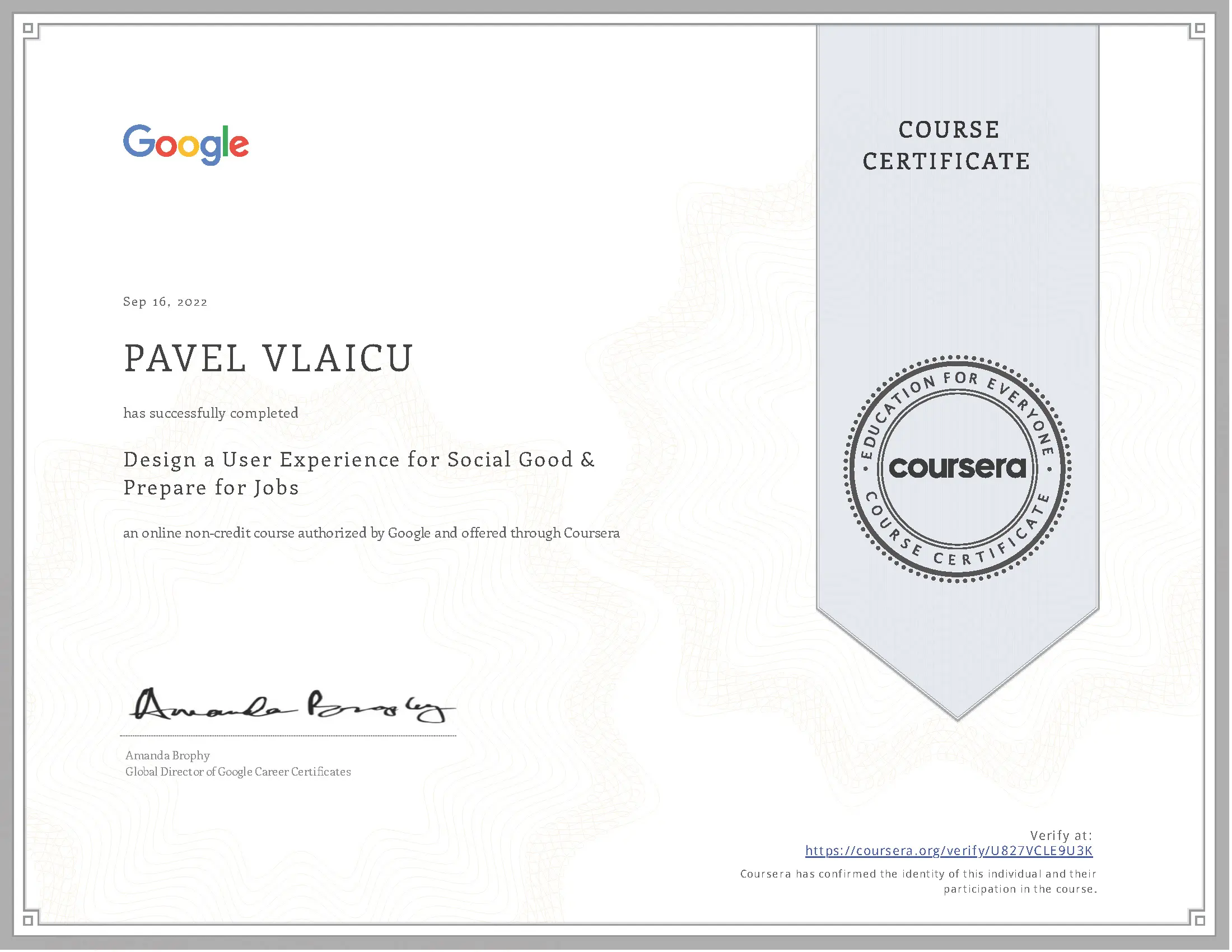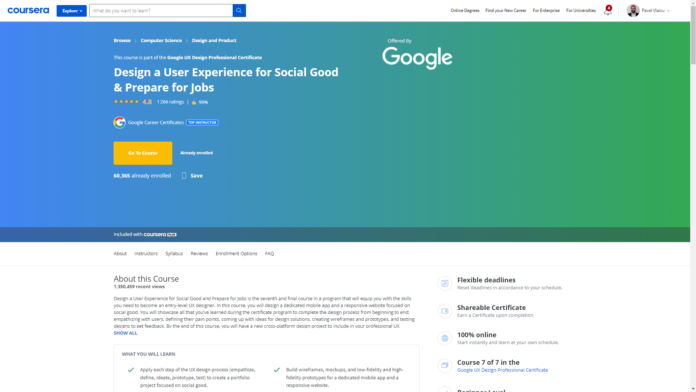About this Course
Design a User Experience for Social Good and Prepare for Jobs is the seventh and final course in a program that will equip you with the skills you need to become an entry-level UX designer. In this course, you will design a dedicated mobile app and a responsive website focused on social good. You will showcase all that you’ve learned during the certificate program to complete the design process from beginning to end: empathizing with users, defining their pain points, coming up with ideas for design solutions, creating wireframes and prototypes, and testing designs to get feedback. By the end of this course, you will have a new cross-platform design project to include in your professional UX portfolio.
This course will also prepare you to land your first job as a UX designer. You’ll learn how to interview for entry-level UX design positions. You’ll get tips from Googlers based on their own interview experiences and their unique perspectives as hiring managers. And, you’ll polish the professional UX portfolio you’ve been building throughout the program so that it’s ready for job applications.
Current UX designers and researchers at Google will serve as your instructors, and you will complete hands-on activities that simulate real-world UX design scenarios. Learners who complete the seven courses in this certificate program should be equipped to apply for entry-level jobs as UX designers.
By the end of this course, you will be able to:
– Apply each step of the UX design process (empathize, define, ideate, prototype, test) to create designs focused on social good.
– Identify the differences between dedicated mobile apps and responsive web apps.
– Understand progressive enhancement and graceful degradation approaches for designing across devices.
– Build wireframes, mockups, and low-fidelity and high-fidelity prototypes in Figma or Adobe XD.
– Add a new design project to your professional UX portfolio.
– Create your portfolio of design work for job applications.
– Join and participate in online UX communities.
– Interview for an entry-level UX design job.
– Determine if freelance design work is a good career fit for you.
This course is suitable for beginner-level UX designers who have completed the previous six courses of the Google UX Design Certificate.
What you will learn
Apply each step of the UX design process (empathize, define, ideate, prototype, test) to create a portfolio project focused on social good.
Build wireframes, mockups, and low-fidelity and high-fidelity prototypes for a dedicated mobile app and a responsive website.
Prepare to successfully interview for an entry-level UX design job.
Determine if freelance design work is a good career fit.
Skills you will gain
User Experience (UX)
Usability Testing
Prototype
User Experience Design (UXD)
UX design jobs
Instructor
Google Career Certificates
Offered by
Google Career Certificates are part of Grow with Google, an initiative that draws on Google’s 20-year history of building products, platforms, and services that help people and businesses grow. Through programs like these, we aim to help everyone– those who make up the workforce of today and the students who will drive the workforce of tomorrow – access the best of Google’s training and tools to grow their skills, careers, and businesses.
Syllabus – What you will learn from this course
Week 1
Starting the UX design process: empathize, define, ideate
You’ve reached the final course of the Google UX Design Certificate — congratulations! You will design a dedicated mobile app and a responsive website focused on social good that showcases everything you’ve learned in the program. To get started, you’ll learn about designing across devices by exploring progressive enhancement and graceful degradation approaches and the 4Cs. With all of this new knowledge, you’ll begin your portfolio project. You’ll start with the empathize phase, where you’ll create personas, user stories, and user journey maps. Then, you’ll move on to the define phase, where you’ll identify the user need your project will focus on and build a problem statement. Finally, you’ll make your way into the ideate phase, where you’ll conduct a competitive audit and come up with ideas for your dedicated mobile app design through sketching.
Week 2
Creating wireframes and low-fidelity prototypes
In this part of the course, you’ll take everything you’ve learned about the user problem you’re trying to solve and come up with a basic version of your dedicated mobile app. You’ll start by creating paper wireframes to come up with lots of ideas. You’ll take the best parts of your paper wireframes and create digital wireframes in Figma or Adobe XD. Next, you’ll turn your digital wireframes into a low-fidelity prototype. Then, you’ll plan and conduct a usability study to get feedback about your low-fidelity prototype, and you’ll make changes to your designs based on insights from your research.
Week 3
Creating mockups and high-fidelity prototypes
Welcome to the world of high-fidelity design! In this part of the course, you will create mockups for your dedicated mobile app that incorporate visual design elements and principles. Along the way, you’ll save elements and components in your design system, which you’ll be able to reuse when you design a responsive website in the next part of the course. Then, you’ll turn your mockups into a high-fidelity prototype. Finally, you’ll have the option to plan and conduct a usability study to gather feedback about your high-fidelity prototype. By the end of this part of the course, your dedicated mobile app designs will be complete, and you will be more than halfway done with your portfolio project.
Week 4
Designing a complementary responsive website
With completed designs for your dedicated mobile app, you’ll take what you learned about your product and users and apply that to design a responsive website for social good. To begin, you’ll learn how to design for different experiences and screen sizes. Next, you’ll review the importance of information architecture and create a sitemap for your website. You’ll also sketch lots of ideas and potential layouts for your website. You’ll create wireframes on paper, digitally, or both for different sized screens. And you’ll develop a low-fidelity prototype and test it through a usability study to improve your designs. Then, you’ll move into high-fidelity designs where you’ll create mockups for different sized screens of your responsive website. Finally, you’ll create a high-fidelity prototype of your responsive website, and test it one more time. By the end of this part of the course, your cross-platform designs will be complete and added to your online portfolio!
Week 5
Building a professional presence
As the digital world continues to expand, companies recognize that designing good user experiences is a necessity, which is why UX design is a high-growth and in-demand job field. The key to landing one of those UX design jobs is a strong portfolio and online presence. In this part of the course, you’ll start to create a portfolio to showcase your upcoming work. You’ll also learn about the importance of having a personal brand and building an online presence.
Week 6
Finding a UX job
In the final part of the Google UX Design Certificate, you’ll prepare to find a job as a new UX designer. You’ll start by making final adjustments to your portfolio to ensure it’s ready to share in job applications. Next, you’ll examine the UX design interview process and develop strategies to succeed in various types of interview: pre-interview research, an elevator pitch, a phone screen, a portfolio presentation, a whiteboard exercise, a take home design exercise, and more. Finally, you’ll explore the world of freelancing by creating a business plan and learning how to land your first client.

